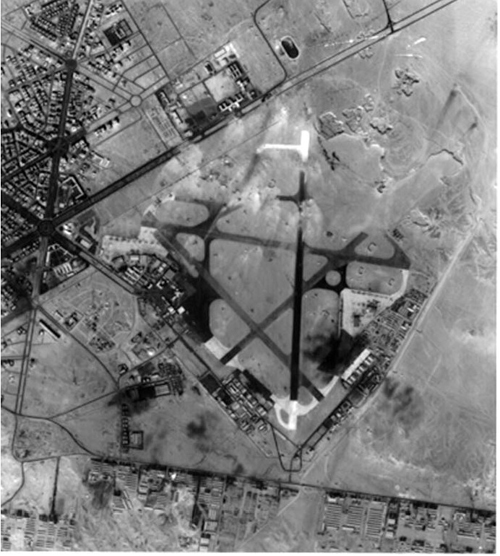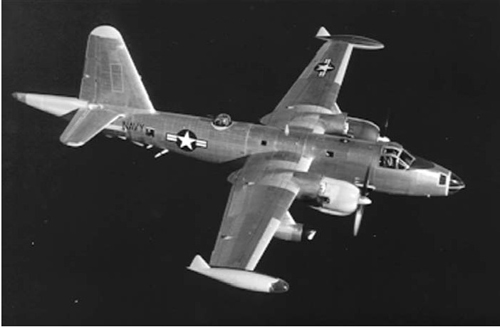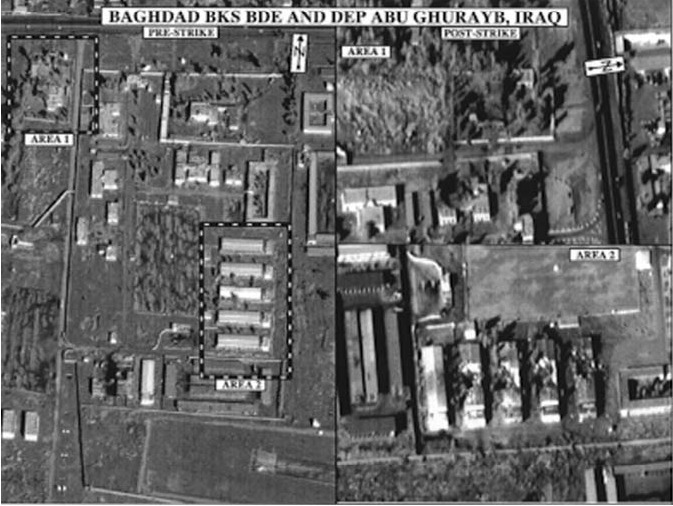The Wizards of Langley (44 page)
Read The Wizards of Langley Online
Authors: Jeffrey T Richelson


(above) U-2 photograph of Almaza airbase, Cairo, after British-French airstrike, November
1, 1956.
CREDIT
: CIA.

(above) The A-12/OXCART aircraft was developed by Lockheed for the CIA as a successor to
the U-2. The plane could fly at over 2,100 miles per hour and at an altitude of over 90,000
feet. The A-12 had a brief operational life, beginning in May 1967 and ending in June 1968,
when it was retired in favor of the Air Force’s A-12 derivative—the SR-71.
CREDIT
: Lockheed

(top right) The U.S. Navy was the primary purchaser of the P-2V Neptune, which it used in
maritime surveillance operations. However, in 1954, the CIA procured several of the aircraft
to use in both covert action and intelligence collection operations—including operations over
the Chinese mainland.
CREDIT
: Lockheed

(bottom right) The CIA Directorate of Science and Technology has been heavily involved in
the development of unmanned aerial vehicle programs. In 1982, the Office of Research and
Development funded work by a small California firm to develop a solar-powered UAV for
surveillance. Today the plane’s successor is used by NASA for environmental research.
CREDIT
: AeroVironment

(above) The SS-9 missile was the source of a major dispute in the intelligence community
in the late 1960s. President Nixon justified the decision to build the Safeguard ABM on the
conclusion, disputed by the DS&T’s Foreign Missile and Space Analysis Center, that the
SS-9 was a MIRVed ICBM, and therefore gave the Soviets a capability for a preemptive
strike on the U.S. ICBM force. The CIA was eventually proved correct.
CREDIT
: U.S. Air
Force

(top right) The Sary Ozek IRBM complex as it appeared in September 1971
CORONA/KH-4B imagery. The KH-4B images has a resolution of about six feet. The first
launch of the successor system, the KH-9/HEXAGON, had taken place in June. KH-9 images
had a resolution of about two feet. The final CORONA launch occurred in May 1972.
CREDIT
: National Reconnaissance Office

(bottom right) Somewhat degraded 1998 advanced KH-11 images of the Baghdad Barracks
Brigade and Depot, Abu Ghurayb, Iraq, before and after U.S. air strikes.
CREDIT
:
Department of Defense

(above) The main ground station for receipt of advanced KH-11 imagery, located at Fort
Belvoir, Virginia. Given the public cover designation Defense Communications Electronics
Evaluation and Testing Activity (DCEETA), within the intelligence community it is designated
Area 58.
CREDIT
: Robert Windrem

(below) The Joint Defense Space Research Facility at Alice Springs, Australia. The facility
has served as the ground control station for CIA-TRW–developed geostationary signals
intelligence satellites, including RHYOLITE/AQUACADE and MAGNUM/ORION.
CREDIT
: Desmond Ball
*After leaving the CIA, Dirks went to work for Raytheon but did not stay long. Bud Wheelon helped bring him to Hughes, but it soon became apparent that he was ill. (Telephone conversation with Bud Wheelon, November 15, 1999.)
*Twetten also noted that there were “two distinct cultures” within the OTS—the engineers who built things and those who went into the field to conduct operations. The former did not necessarily have a good understanding of the operational or weather environment in some areas of the world—for example, Burma. In addition, OTS projects often involved far less money than the DS&T’s large projects—which meant they might receive far less attention from some DS&T managers than the directorate’s larger programs. At the time he served in OTS, Twetten believed it was important to keep the office in the DS&T—as long as there were people in the office who could bridge the gap between engineers and operators. Subsequently, he was not so sure, after becoming aware of increasing frustration from people in OTS about getting funding for their projects. However, he did not attempt, after becoming Deputy Director for Operations in 1991, to have OTS transferred back to the Operations directorate, because it was not worth the “angst” and the “wounds it would cause.” He did establish a small rival group in Operations to help drive OTS to produce the “right equipment.” (Telephone interview with Thomas Twetten, March 12, 2001.)
A NEW WORLD
Evan Hineman’s tenure as Deputy Director for Science and Technology ended on September 5, 1989, his seven years on the job second in length only to Duckett’s among all CIA directorate heads. Stepping into Hine-man’s shoes was deputy James Hirsch—the first science and technology deputy since Duckett to move up to the top job.
The world had changed dramatically during Hineman’s time in office. During his first years as deputy director, the United States and the Soviet Union clashed over the deployment of intermediate-range missiles in Europe, the Strategic Defense Initiative, Afghanistan, the shootdown of KAL flight 007, and a number of other issues. President Ronald Reagan denounced the Soviet Union as an evil empire and “the focus of evil in the modern world.” But a combination of Reagan administration policies and Mikhail Gorbachev’s rise to the top of the Soviet hierarchy in 1985 had a dramatic impact on world events. At the beginning of 1990, Gorbachev would declare that the Cold War had ended.
1
CIA historian Benjamin Fischer labeled 1989 as “the year that changed the world.”
2
The Communist regimes of Eastern Europe fell that year, along with the Berlin Wall. Before another two years were up, the Soviet Union disintegrated—a collapse that removed the restraints on various Soviet client states, including Iraq.
There were also changes in the offing for the intelligence community. There was pressure to do more with less—as many expected to take part of the expected peace dividend out of the intelligence community’s budget. CIA personnel cutbacks reduced its workforce by about 20 percent before the end of the decade. There was also pressure for more openness. In addition, the disappearance of the Soviet enemy brought to the forefront questions of intelligence community structure and targets.
Between 1989 and 1995, those changes affected the DS&T in a variety of ways. The new international environment created new challenges, including a war
that stressed NPIC’s resources. A restructuring of the NRO would have a significant impact on the nature of the directorate’s role in the development of reconnaissance satellites. And since the DS&T’s budget was far greater than that of the other directorates, it was the most vulnerable to cuts.
When James Hirsch assumed command of the science and technology directorate, the Soviet Union was a “fast fading” nation. But the prolonged focus on the Soviet target “skewed the way we did things.” The DS&T had invested heavily in a “frontal technical attack against the Soviet Union.” As a result, the CIA “knew more about [Soviet] telemetry systems than [the Soviets] did.”
3
The heavy focus on the Soviet target meant that the directorate wasn’t entirely prepared to deal with a radically different world. Thus, a study of “imagery collection requirements for the new world order” concluded that the United States would need to obtain images of five times as many point (individual) targets, and photograph ten times the area it did in earlier years. Such conclusions, Hirsch observed, were based on applying the “Soviet model” to the new era, and would not work.
4
The Soviet model involved taking on new missions, regardless of the cost. But money had already been taken out of infrastructure and modernization, and the best the DS&T could hope for in coming years was a flat budget. Stricter priorities would have to be set, particularly given the need to modernize further in several areas, including NPIC.
5
Improving NPIC was only one component of a broader challenge—coping with the digital and information revolutions. The volume of data collected was exploding, the result of more capable collection systems that used digital technology, such as the KH-11, and, in the SIGINT area, the increased volume of signals. There was a need to align processing techniques and capabilities with collection activities. Included was the need to “fuse” data—to combine various types of imagery and other technical data and produce enhanced products.
6
There were also changes in the workforce, and these required that “careers . . . be managed differently.” Career training could no longer be a one-time event that concluded early in the employee’s career. The DS&T required long-term career training to keep personnel conversant with changing targets and technologies.
7
On July 16, 1990, Walter P. “Pat” Lang, the Defense Intelligence Officer for the Middle East and South Asia, carefully studied satellite imagery obtained that morning. A day earlier, nothing was to be seen in southeastern Iraq except empty desert, but on the sixteenth, the story was different. Lang could see part of an Iraqi brigade equipped with Soviet-made T-72 tanks.
8
The next day’s photos were even more disturbing. They showed the entire Hammurabi Division of the Republican Guard—300 tanks and over 10,000 men—positioned near the Kuwaiti border, along with another Republican Guard division. One day later, a third division also showed up in photographs of the border area.
9
The movement of those three divisions to the border was not what the U.S. intelligence community expected. A national intelligence estimate in fall 1989,
Iraq: Foreign Policy of a Major Regional Power
, had concluded that despite Saddam Hussein’s desire to dominate the Gulf region, the eight-year war with Iran had so drained Iraq’s resources that the murderous dictator was unlikely to resort to military action.
10
On July 24, DCI William Webster and Richard Stoltz, the CIA’s deputy director for operations, presented President George Bush with hard evidence of Iraqi movements during an emergency meeting at the White House. The evidence was based substantially on the imagery interpretation efforts of the NPIC analysts who had worked overtime extracting intelligence from the satellite images of southern Iraq.
11
Toward the end of the month, NPIC’s interpreters examined imagery showing that three Iraqi Republican Guard divisions had moved into southern Iraq, and the division normally stationed in the south had moved closer to the Kuwaiti border. In addition, the interpreters were able to identify pontoon-bridging equipment, along with hundreds of heavy tank carriers that would enable Saddam’s heavy armored divisions to move south swiftly before depositing the tanks in the sand to conclude the conquest of Kuwait.
12
A reassuring explanation, accepted by many intelligence analysts, was that the Iraqi dictator was simply using the troop movements to pressure Kuwait in the two countries’ ongoing negotiations over oil. Another was that although Saddam would take some action against Kuwait, it was unlikely that he would try to seize most of the country. That was the prevailing opinion in the CIA until August 2.
13
But such explanations became less believable to Lang as the end of the month approached. The National Intelligence Officer for Warning,
Charles Allen, also believed a major attack was coming. On July 30, Lang prepared a memo for Lt. Gen. Harry Soyster, the DIA’s director, in which he reported that Iraqi movements did not make sense if the only objective was to intimidate Kuwait. Lang wrote, “I do not believe that he is bluffing. I have looked at his personality profile. He doesn’t know how to bluff. It is not in his past pattern of behavior.” The photographs Lang examined on the morning of August 1 led him to issue a warning message predicting an attack by that night or the next morning.
14
On the morning of August 2, 1990, the mechanized infantry, armor, and tank units of the Iraqi Republican Guard invaded Kuwait and seized control of the country. The invasion triggered a U.S. response, Operation Desert Shield, to deter any invasion of Kuwait’s oil-rich neighbor, Saudi Arabia. On August 7, deployment of U.S. forces began. U.N. resolutions condemned Iraq’s invasion and annexation and called for the immediate and unconditional withdrawal of Iraqi forces. On August 20, President Bush signed a national security directive outlining U.S. objectives—which included the “immediate, complete, and unconditional withdrawal of all Iraqi forces from Kuwait” and the “restoration of Kuwait’s legitimate government to replace the puppet regime installed by Iraq.”
15
Implementing that policy would require an intense diplomatic, military, and intelligence effort in the months ahead. A multinational force had to be assembled, operations plan drawn up, and information collected about Iraqi defense systems, conventional offensive capabilities, command and control links, and nuclear, biological, and chemical weapons programs. In the interim, forces would be deployed to Saudi Arabia, as part of Operation Desert Shield, to deter any further hostile action.
A November 29 U.N. ultimatum stipulated that if Saddam did not remove his troops from Kuwait by January 15, a U.S.-led coalition was authorized to drive them out. On January 15, 1991, President Bush signed National Security Directive 54. In the directive’s first paragraph, he observed: “Economic sanctions . . . have had a measurable impact upon Iraq’s economy but have not accomplished the intended objective of ending Iraq’s occupation of Kuwait. There is no persuasive evidence that they will do so in a timely manner.” Later in the directive, he stated that “I hereby authorize military actions designed to bring about Iraq’s withdrawal from Kuwait.”
16
The first step of the campaign began on January 17 with predawn bombing raids on targets in Baghdad and other key locations in Iraq. The targets included command and control facilities, airfields, communication centers, early warning radars, chemical and biological weapons
bunkers, and Baath Party headquarters. Also on the target list were Scud storage and launch sites.
17
The devastating air campaign that began that day was followed on February 22 by the “Hail Mary” ground campaign that would force Iraqi troops out of Kuwait.
U.S. space reconnaissance systems were the primary means of collecting intelligence on Iraq and Kuwait, particularly in the period before military action began. Of particular importance were the imagery satellites the United States had in operation. Three KH-11s were in orbit, although the oldest, launched in 1984, had limited capability.
In addition, there was a satellite, known by the numerical designation 3101 and the code name ONYX, that had been launched in December 1988. Earlier, it (or the program to produce it) had been known as LACROSSE, and before that INDIGO. It was the program that nine years earlier the OD&E had tried to kill by offering to put a radar imagery capability on future versions of the KH-11. Rather than passively depending on reflected visible light or heat to produce imagery, ONYX, as QUILL had three decades earlier, relied on the active radio pulses it generated and then received back from its target. Unlike QUILL, its imagery was not stored in a capsule but transmitted to a relay satellite and then back to the United States. Although the resulting imagery was not in the same class as that of the KH-11, with a resolution of three to five feet, ONYX did have two major advantages. The KH-11 could not produce imagery in the presence of significant cloud cover, which prevented light or heat from reaching the spacecraft sensors, but ONYX could. And whereas the KH-11’s visible light sensors were of little value during darkness, radar imagery systems worked well at night.
18
ONYX had been developed and built by Martin Marietta under the supervision of the Air Force Office of Special Projects, but there was another imagery satellite in orbit—and that was an OD&E product. When first launched from the space shuttle
Atlantis
on March 1, 1990, it was believed to be the first advanced KH-11 spacecraft (the first of which would be launched in 1992). Within weeks, both U.S. and Soviet sources reported it had malfunctioned and would make a “fiery reentry . . . in the next 30 days.”
19
Both assessments were wrong. The payload was a stealth imaging satellite code-named MISTY, which had been developed under the supervision of the DS&T’s development and engineering office.
20
MISTY was one of at least two satellites developed in exceptional secrecy subsequent to the 1983 Reagan administration decision to establish
a stealth satellite program.* The idea for MISTY came from OD&E engineers, some of whom had been enamored of the idea of a stealth satellite since the 1970s—having rediscovered the concept first suggested in the 1960s. The objective was to reduce the threat to U.S. satellites from the Soviet Union—whose antisatellite program was of significant concern during the early 1980s.
21
To help define that threat, OD&E turned to the Directorate of Intelligence’s Office of Scientific and Weapons Research (OSWR)—the office formed in 1980 by the merger of the scientific and weapons intelligence offices that had been transferred to the intelligence directorate in 1976. A Threat Assessment Branch (later Center) in the OSWR Space Systems Division was established and produced an analysis that supported the idea that MISTY could be successful—it argued that Soviet radars and cameras were not very capable and were unlikely to track the satellite. But because the program was so highly compartmented, OD&E did not consult several agencies that had experience in satellite tracking—including the Naval Research Laboratory (NRL), whose engineers might have provided a different assessment about MISTY’s vulnerability to detection.
22
A clue to possible U.S. government interest in stealth satellites was supplied just weeks after MISTY’s launch. To the anger of many in the NRO, a patent application was filed, apparently by the SDIO, for a “Satellite Signature Suppression Shield.” The application described an inflatable shield that could protect satellites from detection by radar, laser, infrared, and optical systems.
23
